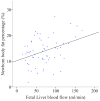Prospective association of fetal liver blood flow at 30 weeks gestation with newborn adiposity
- PMID: 28433734
- PMCID: PMC5545060
- DOI: 10.1016/j.ajog.2017.04.022
Prospective association of fetal liver blood flow at 30 weeks gestation with newborn adiposity
Abstract
Background: The production of variation in adipose tissue accretion represents a key fetal adaptation to energy substrate availability during gestation. Because umbilical venous blood transports nutrient substrate from the maternal to the fetal compartment and because the fetal liver is the primary organ in which nutrient interconversion occurs, it has been proposed that variations in the relative distribution of umbilical venous blood flow shunting either through ductus venosus or perfusing the fetal liver represents a mechanism underlying this adaptation.
Objective: The objective of the present study was to determine whether fetal liver blood flow assessed before the period of maximal fetal fat deposition (ie, the third trimester of gestation) is prospectively associated with newborn adiposity.
Study design: A prospective study was conducted in a cohort of 62 uncomplicated singleton pregnancies. Fetal ultrasonography was performed at 30 weeks gestation for conventional fetal biometry and characterization of fetal liver blood flow (quantified by subtracting ductus venosus flow from umbilical vein flow). Newborn body fat percentage was quantified by dual energy X-ray absorptiometry imaging at 25.8 ± 3.3 (mean ± standard error of the mean) postnatal days. Multiple regression analysis was used to determine the proportion of variation in newborn body fat percentage explained by fetal liver blood flow. Potential confounding factors included maternal age, parity, prepregnancy body mass index, gestational weight gain, gestational age at birth, infant sex, postnatal age at dual energy X-ray absorptiometry scan, and mode of infant feeding.
Results: Newborn body fat percentage was 13.5% ± 2.4% (mean ± standard error of the mean). Fetal liver blood flow at 30 weeks gestation was significantly and positively associated with newborn total fat mass (r=0.397; P<.001) and body fat percentage (r=0.369; P=.004), but not with lean mass (r=0.100; P=.441). After accounting for the effects of covariates, fetal liver blood flow explained 13.5% of the variance in newborn fat mass. The magnitude of this association was pronounced particularly in nonoverweight/nonobese mothers (prepregnancy body mass index, <25 kg/m2; n=36) in whom fetal liver blood flow explained 24.4% of the variation in newborn body fat percentage.
Conclusion: Fetal liver blood flow at the beginning of the third trimester of gestation is associated positively with newborn adiposity, particularly among nonoverweight/nonobese mothers. This finding supports the role of fetal liver blood flow as a putative fetal adaptation underlying variation in adipose tissue accretion.
Keywords: body composition; body fat percentage; fetal ultrasonography; liver blood flow; prepregnancy body mass index.
Copyright © 2017 Elsevier Inc. All rights reserved.
Conflict of interest statement
Figures


Similar articles
-
Maternal insulin resistance in pregnancy is associated with fetal fat deposition: findings from a longitudinal study.Am J Obstet Gynecol. 2023 Apr;228(4):455.e1-455.e8. doi: 10.1016/j.ajog.2022.10.015. Epub 2022 Oct 23. Am J Obstet Gynecol. 2023. PMID: 36283481
-
Placental Corticotrophin-Releasing Hormone is a Modulator of Fetal Liver Blood Perfusion.J Clin Endocrinol Metab. 2021 Mar 8;106(3):646-653. doi: 10.1210/clinem/dgaa908. J Clin Endocrinol Metab. 2021. PMID: 33313841 Free PMC article.
-
Fetal liver blood flow distribution: role in human developmental strategy to prioritize fat deposition versus brain development.PLoS One. 2012;7(8):e41759. doi: 10.1371/journal.pone.0041759. Epub 2012 Aug 22. PLoS One. 2012. PMID: 22927915 Free PMC article.
-
Effect of maternal metabolism on fetal growth and body composition.Diabetes Care. 1998 Aug;21 Suppl 2:B85-90. Diabetes Care. 1998. PMID: 9704233 Review.
-
Regulation of blood flow through the ductus venosus.J Dev Physiol. 1980 Aug;2(4):219-38. J Dev Physiol. 1980. PMID: 7012226 Review.
Cited by
-
The effect of a maternal meal on fetal liver blood flow.PLoS One. 2019 Jun 12;14(6):e0216176. doi: 10.1371/journal.pone.0216176. eCollection 2019. PLoS One. 2019. PMID: 31188835 Free PMC article.
-
Origins of obesity in the womb: Fetal adiposity and its determinants.J Obstet Gynaecol Res. 2024 Dec;50(12):2178-2182. doi: 10.1111/jog.16114. Epub 2024 Oct 9. J Obstet Gynaecol Res. 2024. PMID: 39385507 Free PMC article. Review.
-
Newer Insights Into Fetal Growth and Body Composition.Front Endocrinol (Lausanne). 2021 Jul 22;12:708767. doi: 10.3389/fendo.2021.708767. eCollection 2021. Front Endocrinol (Lausanne). 2021. PMID: 34367074 Free PMC article. Review.
-
Recent Insights and Recommendations for Preventing Excessive Gestational Weight Gain.J Clin Med. 2024 Mar 2;13(5):1461. doi: 10.3390/jcm13051461. J Clin Med. 2024. PMID: 38592297 Free PMC article. Review.
-
Altered development of fetal liver perfusion in pregnancies with pregestational diabetes.PLoS One. 2019 Mar 13;14(3):e0211788. doi: 10.1371/journal.pone.0211788. eCollection 2019. PLoS One. 2019. PMID: 30865630 Free PMC article.
References
-
- Ebbeling CB, Pawlak DB, Ludwig DS. Childhood obesity: public-health crisis, common sense cure. The Lancet. 2002;360:473–82. - PubMed
-
- Catalano PM, Tyzbir ED, Allen SR, McBean JH, McAuliffe TL. Evaluation of fetal growth by estimation of neonatal body composition. Obstet Gynecol. 1992;79:46–50. - PubMed
-
- Boney CM, Verma A, Tucker R, Vohr BR. Metabolic syndrome in childhood: association with birth weight, maternal obesity, and gestational diabetes mellitus. Pediatrics. 2005;115:e290–6. - PubMed
Publication types
MeSH terms
Grants and funding
LinkOut - more resources
Full Text Sources
Other Literature Sources

